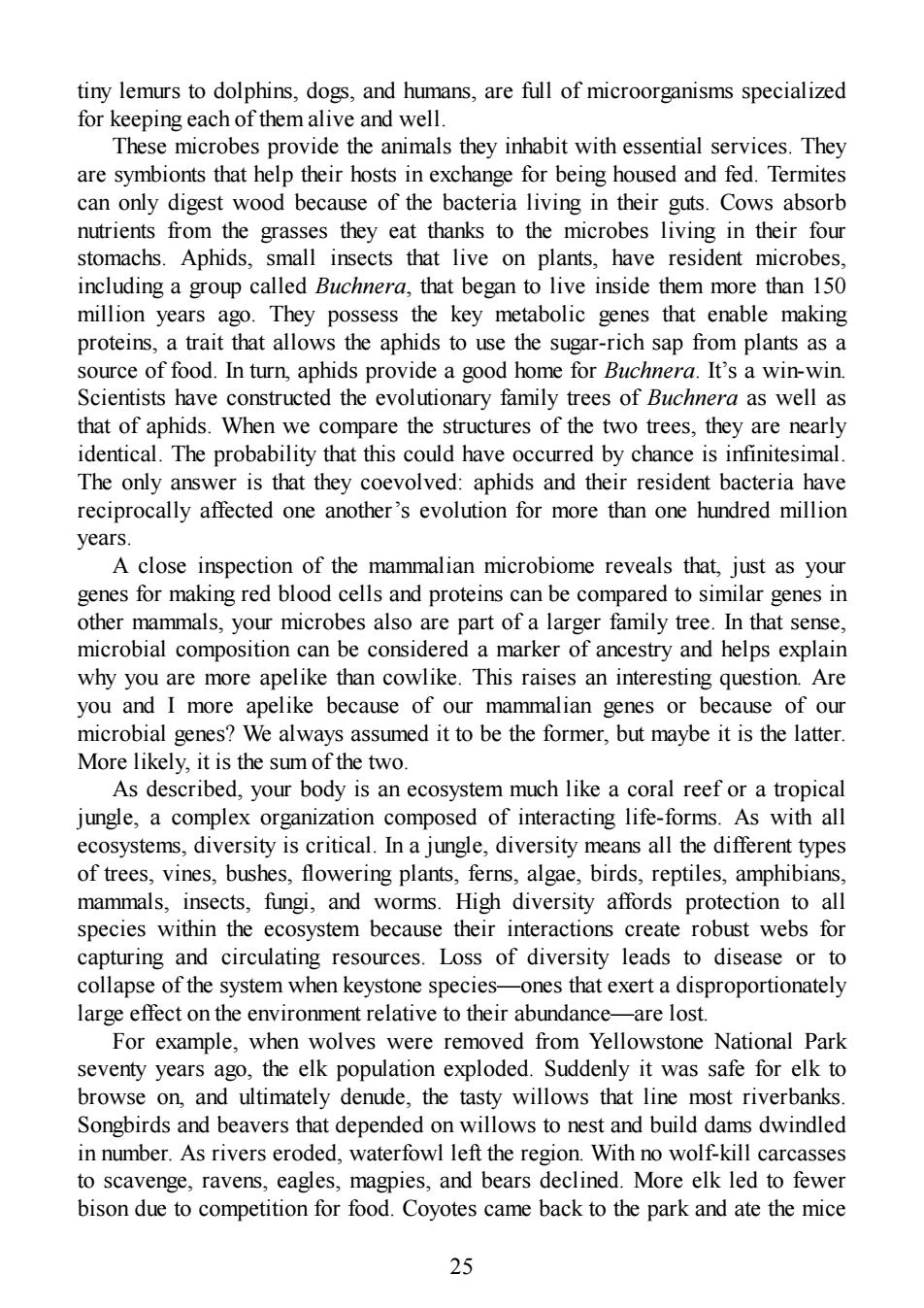正在加载图片...

tiny lemurs to dolphins,dogs,and humans,are full of microorganisms specialized for keeping each of them alive and well These microbes provide the animals they inhabit with essential services.They are symbionts that help their hosts in exchange for being housed and fed.Termites can only digest wood because of the bacteria living in their guts.Cows absorb nutrients from the grasses they eat thanks to the microbes living in their four stomachs.Aphids,small insects that live on plants,have resident microbes, including a group called Buchnera,that began to live inside them more than 150 million years ago.They possess the key metabolic genes that enable making proteins,a trait that allows the aphids to use the sugar-rich sap from plants as a source of food.In turn,aphids provide a good home for Buchnera.It's a win-win. Scientists have constructed the evolutionary family trees of Buchnera as well as that of aphids.When we compare the structures of the two trees,they are nearly identical.The probability that this could have occurred by chance is infinitesimal The only answer is that they coevolved:aphids and their resident bacteria have reciprocally affected one another's evolution for more than one hundred million years A close inspection of the mammalian microbiome reveals that,just as your genes for making red blood cells and proteins can be compared to similar genes in other mammals,your microbes also are part of a larger family tree.In that sense, microbial composition can be considered a marker of ancestry and helps explain why you are more apelike than cowlike.This raises an interesting question.Are you and I more apelike because of our mammalian genes or because of our microbial genes?We always assumed it to be the former,but maybe it is the latter. More likely,it is the sum of the two. As described,your body is an ecosystem much like a coral reef or a tropical jungle,a complex organization composed of interacting life-forms. As with all ecosystems,diversity is critical.In a jungle,diversity means all the different types of trees,vines,bushes,flowering plants,ferns,algae,birds,reptiles,amphibians, mammals,insects,fungi,and worms.High diversity affords protection to all species within the ecosystem because their interactions create robust webs for capturing and circulating resources.Loss of diversity leads to disease or to collapse of the system when keystone species-ones that exert a disproportionately large effect on the environment relative to their abundance-are lost. For example,when wolves were removed from Yellowstone National Park seventy years ago,the elk population exploded.Suddenly it was safe for elk to browse on,and ultimately denude,the tasty willows that line most riverbanks Songbirds and beavers that depended on willows to nest and build dams dwindled in number.As rivers eroded,waterfowl left the region.With no wolf-kill carcasses to scavenge,ravens,eagles,magpies,and bears declined.More elk led to fewer bison due to competition for food.Coyotes came back to the park and ate the mice 25 tiny lemurs to dolphins, dogs, and humans, are full of microorganisms specialized for keeping each of them alive and well. These microbes provide the animals they inhabit with essential services. They are symbionts that help their hosts in exchange for being housed and fed. Termites can only digest wood because of the bacteria living in their guts. Cows absorb nutrients from the grasses they eat thanks to the microbes living in their four stomachs. Aphids, small insects that live on plants, have resident microbes, including a group called Buchnera, that began to live inside them more than 150 million years ago. They possess the key metabolic genes that enable making proteins, a trait that allows the aphids to use the sugar-rich sap from plants as a source of food. In turn, aphids provide a good home for Buchnera. It’s a win-win. Scientists have constructed the evolutionary family trees of Buchnera as well as that of aphids. When we compare the structures of the two trees, they are nearly identical. The probability that this could have occurred by chance is infinitesimal. The only answer is that they coevolved: aphids and their resident bacteria have reciprocally affected one another’s evolution for more than one hundred million years. A close inspection of the mammalian microbiome reveals that, just as your genes for making red blood cells and proteins can be compared to similar genes in other mammals, your microbes also are part of a larger family tree. In that sense, microbial composition can be considered a marker of ancestry and helps explain why you are more apelike than cowlike. This raises an interesting question. Are you and I more apelike because of our mammalian genes or because of our microbial genes? We always assumed it to be the former, but maybe it is the latter. More likely, it is the sum of the two. As described, your body is an ecosystem much like a coral reef or a tropical jungle, a complex organization composed of interacting life-forms. As with all ecosystems, diversity is critical. In a jungle, diversity means all the different types of trees, vines, bushes, flowering plants, ferns, algae, birds, reptiles, amphibians, mammals, insects, fungi, and worms. High diversity affords protection to all species within the ecosystem because their interactions create robust webs for capturing and circulating resources. Loss of diversity leads to disease or to collapse of the system when keystone species—ones that exert a disproportionately large effect on the environment relative to their abundance—are lost. For example, when wolves were removed from Yellowstone National Park seventy years ago, the elk population exploded. Suddenly it was safe for elk to browse on, and ultimately denude, the tasty willows that line most riverbanks. Songbirds and beavers that depended on willows to nest and build dams dwindled in number. As rivers eroded, waterfowl left the region. With no wolf-kill carcasses to scavenge, ravens, eagles, magpies, and bears declined. More elk led to fewer bison due to competition for food. Coyotes came back to the park and ate the mice 25